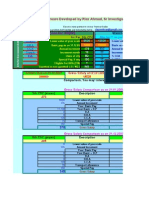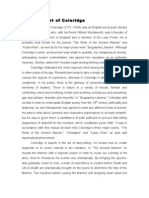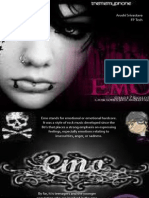Kubla Khan
Kubla Khan
Uploaded by
vanilla_42kpCopyright:
Available Formats
Kubla Khan
Kubla Khan
Uploaded by
vanilla_42kpOriginal Description:
Copyright
Available Formats
Share this document
Did you find this document useful?
Is this content inappropriate?
Copyright:
Available Formats
Kubla Khan
Kubla Khan
Uploaded by
vanilla_42kpCopyright:
Available Formats
Imagine Passion: A Look at the Poem "Kubla Khan" by Samuel Taylor Coleridge
How Coleridge Uses Images from Nature to Depict Erotic Sexual Experiences
As famous French writer Stendhal comments, "Pleasure is often spoiled by describing it." Perhaps that is why some people just hate to read romance. It seems that something in the pleasure of sexuality is lost when it hits the pages of a trashy romance novel. Ages before contemporary writers such as Nora Roberts began pouring steamy affairs onto the pages of paperbacks, poets such as Samuel Taylor Coleridge perfected the art of describing pleasure without spoiling it. In an example of this perfection, Coleridge's poem "Kubla Khan" uses images from nature to describe the intense pleasure found in the sensations of a sexual experience, through the metaphor of a palace, comparing this pleasure also to the joy of experiencing great creative inspiration. The poem can be broken down into three sections. In the first section, lines 1 to 11, Coleridge sets up the metaphor of the palace. He uses natural imagery to give the feeling that this palace is like a beautiful woman. In line 2, he introduces the topic, referring to it as "a stately pleasure-dome," which he based on a line in Samuel Purchas' book, Purchas his Pilgrimage, which says, "Here the Khan Kubla commanded a palace to be built and a stately garden thereunto." In presenting "Kubla Khan," Coleridge explained that he had read this line just before drifting into an opium-induced sleep, and thus the poem is a result of this vision. Because Coleridge introduces the palace as a "pleasure-dome," the tone of the poem is therefore marked to be about pleasure and sensuality. In describing the palace in the first section of the poem, Coleridge uses language that is suggestive of a woman and her fertility, as he describes "caverns measureless to man" and "fertile ground" (4-6), as well as towers that were "girdled round" (7) and gardens that "blossomed" (9) as they were "enfolding" the greenery (11). With the caverns and the fertile ground seemingly representing a womb, while the following lines represent a beautiful body, these words paint a picture of a womanly image, showing the parallel desire for the pleasure-dome as the desire of a man for a fertile woman. From here, the poem goes further into this metaphor. In the second section, lines 12 to 36, he explores the pleasuredome, romancing the woman and experiencing the sensations of foreplay, then intercourse, and finally the moments of relaxation that follow. He describes these in terms of nature, showing the great contrast of the peacefulness and the climax. First, he describes the palace, or her body, as "holy and enchanted" (14), and then, in contrast to the purity of this image, describes the woman as "wailing for her demon-lover" (16). He uses this image of the "woman wailing for her demon-lover" (16) to describe the look of the pleasure-dome in the moon. This peaceful image depicts the rhythmic feel of a passionate foreplay, which precedes the contrasting image Coleridge gives of intercourse, "as if this earth in fast thick pants were breathing" (18). What follows this, in lines 19 to 24, is the description of his climax. It is hard to even decipher what part of the palace of garden he is describing as he details the "mighty fountain" (19) as it "flung up momently the sacred river" (24), portraying the man's orgasm. Using these images of water, he distinguishes the intensity of the climax from the relaxing release that follows, as he again mentions the sacred river, but this time it is "meandering with a mazy motion" (25-26). This image is like the sperm, as if they are swimming peacefully upstream. The tone shifts again to a more powerful image when they reach the "caverns measureless to man" (27), and sink "in tumult to a lifeless ocean" (28), which perhaps refers to how incredible it is that when fertilization occurs a life is created out of something that was previously lifeless. Coleridge then zooms out the metaphor in lines 31 to 36, looking again at the larger picture of the palace, this time describing the "shadow of the pleasure-dome" (31). Possible he mentions the "shadow" to show that he is reminiscing on his experience, completing this section with another image of great contrast, "It was a miracle of rare device, a sunny pleasure-dome with caves of ice!" (35-36), and thus ends the metaphor of the palace.
The metaphor then shifts in the final section, in lines 37-54, again using a woman, although this time having little connection to the palace. Here he describes the song of a female musician, illustrating "a damsel with a dulcimer," (37) whom he saw in a vision. Whereas the previous sections used the palace as a metaphor for an experience with a woman, this woman seems to be the metaphor, symbolizing the experiencing of creative inspiration. The connection lies in the intensity of the experience; the woman's song in the vision was so incredible that it brings back the sensation of intercourse, inciting in him a desire to "build that dome in air" (46). The poem has previously set up the dome as being linked to sexual pleasure, yet here he is talking about the desire to "revive her symphony and song" (42-43), now discussing the pleasure provided by art, and as he alludes to a ritual traditionally used to protect poets, it shows that his pleasure here is as a result of poetic inspiration. The delight this inspiration provides is so incredible that it turns him into a madman, that "all should cry, 'Beware! Beware!' His flashing eyes, his floating hair!" (49-50). The notion of "flashing eyes" and "floating hair" could also be linked to the sexual imagery Coleridge employs in the poem, as a man in the height of passion. He ends the poem with a reference to Plato's Ion, where it compares inspired poets to maidens who are not in their right minds when they draw milk. With a somewhat sexual connotation, Coleridge relates his inspiration to having "drunk the milk of paradise" (54). The fact that it is "paradise" leads back to the natural garden atmosphere of the pleasure-dome. Furthermore, the reference to milk, which in Ion was gathered by maidens, hints at the connection between sexual pleasure and the joy of creative inspiration. Taking the poem in a different perspective, one could explore the concept of drugs as a source of pleasure, since the entire poem was admittedly created as the result of taking opium. As rich in imagery as the poem is, "Kubla Khan" in notably a mark of Coleridge's genius as a poet, raising the question of the impact of the opium on his poetry. As line 38 of the poem points out, the woman's song was heard in a vision; it could be argued that the "deep delight 'twould win" (44) Coleridge only as the opium inspires him. What is the ultimate source of pleasure? What is the ultimate source of inspiration? Whether it is drug-induced or not, it seems that Coleridge would say it is imagination. As Coleridge wrote in Chapter 13 of Biographia Liter aria, imagination is "the living power and prime agent of all human perception." Imagination is pleasure; it is creation; it is everything! Works Cited Coleridge, Samuel Taylor. "Kubla Khan." Greenblatt, Stephen, ed. The Norton Anthology of English Literature. 8th ed. New York: W.W. Norton & Company, 2006. 446-448.
=-=-=-=-=-=-=-=-=-=-=-=-=-=-=-= Kubla Khan
You might also like
- 6th Central Pay Commission Salary CalculatorDocument15 pages6th Central Pay Commission Salary Calculatorrakhonde100% (436)
- Blake Divine ImageDocument2 pagesBlake Divine ImageanjumdkNo ratings yet
- Kubla KhanDocument2 pagesKubla KhanKhairul Islam Pranto100% (1)
- Context ST ColeridgeDocument3 pagesContext ST ColeridgeIrfan Raza100% (1)
- Kubla Khan AnalizaDocument3 pagesKubla Khan AnalizaMada AnandiNo ratings yet
- Solitary ReaperDocument2 pagesSolitary ReaperKirstenalex100% (2)
- P.B.Shelley and Keats As Second GeneratiDocument29 pagesP.B.Shelley and Keats As Second GeneratiDanyal KhanNo ratings yet
- tmp9634 TMPDocument24 pagestmp9634 TMPFrontiersNo ratings yet
- Escapism in Romantic Poetry and Conventional PoetryDocument8 pagesEscapism in Romantic Poetry and Conventional PoetryHania Eng21No ratings yet
- A City's Death by FireDocument4 pagesA City's Death by FireQandeel FatimaNo ratings yet
- John Keats As Aan EscaptistDocument2 pagesJohn Keats As Aan Escaptistجاوید اقبال صدیقیNo ratings yet
- Easter 1916 by W B Yeats Critical AnalysDocument6 pagesEaster 1916 by W B Yeats Critical Analyspriyanshigoyal0102No ratings yet
- Lucy GrayDocument4 pagesLucy GrayDash Hunter100% (4)
- Pedestrian Politics: William Wordsworth's The Old Cumberland BeggarDocument5 pagesPedestrian Politics: William Wordsworth's The Old Cumberland BeggarMuhammad Furqan Aslam AwanNo ratings yet
- Life and Times of John MiltonDocument28 pagesLife and Times of John MiltonRohanChoudharyNo ratings yet
- The Faerie Queene Book 1, Canto 1Document1 pageThe Faerie Queene Book 1, Canto 1evelynjlt813No ratings yet
- Toads AnalysisDocument3 pagesToads AnalysisMohana DasNo ratings yet
- Literary Essay The University WitsDocument6 pagesLiterary Essay The University Witsgull skNo ratings yet
- Acquainted With The NightDocument6 pagesAcquainted With The NightAmber FatimaNo ratings yet
- Larkin Ambulances1Document4 pagesLarkin Ambulances1Sumaira MalikNo ratings yet
- Shelley-Ode To West WindDocument4 pagesShelley-Ode To West Windbharat_sasi100% (2)
- The Elegy Written in A Country Churchyard: Thomas GrayDocument20 pagesThe Elegy Written in A Country Churchyard: Thomas Graymarie91No ratings yet
- Chapters of Biographia LiterariaDocument7 pagesChapters of Biographia Literariashah nawazNo ratings yet
- 6.because I Could Not AnalysesDocument16 pages6.because I Could Not AnalysesFuad Mahmud Abir GUBNo ratings yet
- Donne As A Metaphysical PoetDocument4 pagesDonne As A Metaphysical PoetAsadNo ratings yet
- PreludeDocument8 pagesPreludeKristi CooperNo ratings yet
- HopkinsDocument9 pagesHopkinssazzad hossainNo ratings yet
- S. Sulochana Rengachari - T S Eliot - Hamlet and His Problems - An Analysis-Prakash Book Depot (2013)Document50 pagesS. Sulochana Rengachari - T S Eliot - Hamlet and His Problems - An Analysis-Prakash Book Depot (2013)pallavi desaiNo ratings yet
- Traditional Symbolism in Kubla KhannDocument5 pagesTraditional Symbolism in Kubla KhannMelanie HadzegaNo ratings yet
- Essay On Ophelia The Innocent Victim in ShakespeareDocument3 pagesEssay On Ophelia The Innocent Victim in Shakespearemanazar hussainNo ratings yet
- Timelessness and Eternity: Finding Beauty Is Truth Within Keats's Ode On A Grecian UrnDocument2 pagesTimelessness and Eternity: Finding Beauty Is Truth Within Keats's Ode On A Grecian UrnErika LloydNo ratings yet
- EcstasyDocument5 pagesEcstasyanmansariNo ratings yet
- Discuss Mourning Becomes Electra As A Tragedy in Modern SenseDocument3 pagesDiscuss Mourning Becomes Electra As A Tragedy in Modern SensevecantstareNo ratings yet
- Kubla Khan 345-6Document12 pagesKubla Khan 345-6SARWALNo ratings yet
- Existence of God - DR Faustus and Waiting For GodotDocument12 pagesExistence of God - DR Faustus and Waiting For Godoteqb007No ratings yet
- How Elements of Humor Are Used To Depict Coketown and Its Dwellers (The Gradgrindsand Mr. Bounderby) in Hard Times by Charles Dickens.Document4 pagesHow Elements of Humor Are Used To Depict Coketown and Its Dwellers (The Gradgrindsand Mr. Bounderby) in Hard Times by Charles Dickens.Leila Evaristo100% (1)
- Jimmy PorterDocument11 pagesJimmy PorterKeerthi AjayNo ratings yet
- Traits of Charles Lamb EssaysDocument3 pagesTraits of Charles Lamb EssaysDaffodilNo ratings yet
- xINTRODUCING LITERATURE ENG1B01 PDFDocument65 pagesxINTRODUCING LITERATURE ENG1B01 PDFAneeshya Sunil100% (1)
- Prlude AutobiographyDocument3 pagesPrlude AutobiographyMuhammad Zameer JafarNo ratings yet
- States of The Human Soul.: William BlakeDocument3 pagesStates of The Human Soul.: William BlakeSimona CrihanNo ratings yet
- Among School ChildrenDocument3 pagesAmong School ChildrenNur BakhtNo ratings yet
- William Blake BiografyDocument2 pagesWilliam Blake BiografyMariana DiaconuNo ratings yet
- Hamlet's ProcrastinationDocument3 pagesHamlet's Procrastinationrifahrafiaislam1No ratings yet
- " Thou Hast Made Me, and Shall Thy Work Decay?Document2 pages" Thou Hast Made Me, and Shall Thy Work Decay?Sbgacc SojitraNo ratings yet
- Ma 3Document6 pagesMa 3surendersinghmdnrNo ratings yet
- When Lilacs LastDocument30 pagesWhen Lilacs Lastapi-306538760No ratings yet
- A Slumber Did My Spirit SealDocument87 pagesA Slumber Did My Spirit SealUPASANA TARAFDERNo ratings yet
- Coleridge and His Gothic Style of WritingDocument2 pagesColeridge and His Gothic Style of WritingarushiNo ratings yet
- Narrative Art of ColeridgeDocument8 pagesNarrative Art of ColeridgeShafaq TahirNo ratings yet
- Analysis of The Force That Through The Green FuseDocument8 pagesAnalysis of The Force That Through The Green FuseKazuma Sato100% (1)
- Task 3 - Illustrating Marxist CriticismDocument10 pagesTask 3 - Illustrating Marxist CriticismTroJaf OfficialNo ratings yet
- A Brief History of Malayalam FictionDocument5 pagesA Brief History of Malayalam Fictionzehra nishatNo ratings yet
- Savitri Book 1 Canto 1 Post 5Document3 pagesSavitri Book 1 Canto 1 Post 5api-3740764No ratings yet
- Twelfth Nigh As A Romantic ComedyDocument2 pagesTwelfth Nigh As A Romantic ComedyMIJANUL HAQUENo ratings yet
- Our Casurina TreeDocument12 pagesOur Casurina TreeAshique ElahiNo ratings yet
- Literary Terms PDFDocument3 pagesLiterary Terms PDFSubhajitNo ratings yet
- Blake: LondonDocument3 pagesBlake: LondongisyronNo ratings yet
- Milton and Shakespeare (Ignou)Document40 pagesMilton and Shakespeare (Ignou)simranmoon2002No ratings yet
- Thomas Gray: Transitional PoetDocument24 pagesThomas Gray: Transitional PoetAmäl HåmDy100% (1)
- Online ESL Audio ResourcesDocument3 pagesOnline ESL Audio Resourcesvanilla_42kpNo ratings yet
- Why Boys Fail in CollegeDocument2 pagesWhy Boys Fail in Collegevanilla_42kp83% (6)
- Clause AnalysisDocument3 pagesClause Analysisvanilla_42kpNo ratings yet
- Hedda Gabler Power Point GOODDocument32 pagesHedda Gabler Power Point GOODvanilla_42kpNo ratings yet
- Ʃ/ and /Ʒ/ SoundsDocument9 pagesƩ/ and /Ʒ/ Soundsvanilla_42kp100% (1)
- Punctuation Capitalization RulesDocument5 pagesPunctuation Capitalization Rulesvanilla_42kpNo ratings yet
- The Spanish Civil War-For Whom The Bell TollsDocument7 pagesThe Spanish Civil War-For Whom The Bell Tollsvanilla_42kpNo ratings yet
- Experimental Research - Research DesignDocument5 pagesExperimental Research - Research Designvanilla_42kpNo ratings yet
- Drama in Language TeachingDocument14 pagesDrama in Language Teachingvanilla_42kp100% (1)
- Experimental Research - Research DesignDocument15 pagesExperimental Research - Research Designvanilla_42kpNo ratings yet
- Urdu To English ProverbsDocument20 pagesUrdu To English Proverbsvanilla_42kp67% (3)
- Sources of Knowledge: Dr. Syed Rifaat Hussain Professor and Chairman, DSS Department, QAU, IslamabadDocument8 pagesSources of Knowledge: Dr. Syed Rifaat Hussain Professor and Chairman, DSS Department, QAU, Islamabadvanilla_42kpNo ratings yet
- Has Have HadDocument5 pagesHas Have Hadvanilla_42kp100% (2)
- Common English Spelling Rules and Exceptions GOODDocument3 pagesCommon English Spelling Rules and Exceptions GOODvanilla_42kp100% (1)
- Verb Tense Chart Based On Azar: Understanding & Using English GrammarDocument1 pageVerb Tense Chart Based On Azar: Understanding & Using English GrammarHanna0% (1)
- Ariel by Sylvia PlathDocument5 pagesAriel by Sylvia Plathvanilla_42kpNo ratings yet
- Difference Between "No" and "Not"Document1 pageDifference Between "No" and "Not"vanilla_42kpNo ratings yet
- A/L English Literature PaperDocument4 pagesA/L English Literature PaperNoël Perera100% (1)
- History of Indian Cinema For FTIIDocument2 pagesHistory of Indian Cinema For FTIITARUN KAPOORNo ratings yet
- British Vs - American EnglishDocument5 pagesBritish Vs - American EnglishOana IoanaNo ratings yet
- CPE BachDocument5 pagesCPE BacheliasNo ratings yet
- 2006 Mapex CatalogDocument33 pages2006 Mapex Catalogijocmac100% (1)
- 38 Lessons Todd Hido Has Taught Me About PhotographyDocument60 pages38 Lessons Todd Hido Has Taught Me About PhotographyMóni ViláNo ratings yet
- ASILIMITED Barclays CenterDocument2 pagesASILIMITED Barclays CenterNorman OderNo ratings yet
- Arushi Srivastava FP TechDocument19 pagesArushi Srivastava FP TechArushi SrivastavaNo ratings yet
- Design Elements Typogrphy FundamentalsDocument161 pagesDesign Elements Typogrphy FundamentalsphichitoNo ratings yet
- Sia Piano ChordDocument5 pagesSia Piano ChordMiche Cotorás ZolezziNo ratings yet
- Chick Corea Spain Jazz Lick Lesson - Free Jazz LessonsDocument5 pagesChick Corea Spain Jazz Lick Lesson - Free Jazz LessonsP ZNo ratings yet
- Code Mixing and Code SwitchingDocument4 pagesCode Mixing and Code SwitchingdyoNo ratings yet
- The Warburg InstituteDocument6 pagesThe Warburg Institutecadu_riccioppoNo ratings yet
- Seduction LyricsDocument14 pagesSeduction Lyricsz_k_j_vNo ratings yet
- New Hindi Films Attract Huge New Fan Foundation.20121223.153006Document1 pageNew Hindi Films Attract Huge New Fan Foundation.20121223.153006anon_131493618No ratings yet
- History of The Renaissance in FranceDocument368 pagesHistory of The Renaissance in FranceMelissaPerezNo ratings yet
- Group of Five Paintings by Vilhelm Hammershøi Lead Sotheby's London Sale of European PaintingsDocument3 pagesGroup of Five Paintings by Vilhelm Hammershøi Lead Sotheby's London Sale of European PaintingsGavelNo ratings yet
- Baroque Architecture and The RenaissanceDocument9 pagesBaroque Architecture and The RenaissanceSonika JagadeeshkumarNo ratings yet
- Adrian Smith (Architect)Document5 pagesAdrian Smith (Architect)Tasawar ShahNo ratings yet
- Paul'S Solo (Live) : A 1st Section 90Document11 pagesPaul'S Solo (Live) : A 1st Section 90Charlie DaysNo ratings yet
- Native American Myths: Coyote Finishes His WorkDocument25 pagesNative American Myths: Coyote Finishes His WorkAnonymous gQBs93LNo ratings yet
- Dont Look BackDocument6 pagesDont Look BackMay SantosNo ratings yet
- Secrets of The Diminished ScaleDocument4 pagesSecrets of The Diminished ScalethomasfigNo ratings yet
- Region 5 Music and Dance AceDocument7 pagesRegion 5 Music and Dance Acejunjun67% (3)
- Conditionals: Other Expressions (Unless, Should, As Long As)Document1 pageConditionals: Other Expressions (Unless, Should, As Long As)Susan Sue Berrospi MerinoNo ratings yet
- The Mountain HousesDocument11 pagesThe Mountain HousesClarissa LicoNo ratings yet
- Arth Is Pleased To Announce The ArrivalDocument10 pagesArth Is Pleased To Announce The ArrivalHsk KogilanNo ratings yet
- NEW - 1 - The Analysis of A TextDocument2 pagesNEW - 1 - The Analysis of A TextGaluhJgsNo ratings yet
- Life Upper-Intermediate TOC SBDocument4 pagesLife Upper-Intermediate TOC SBAbraham BongòNo ratings yet
- Complete Viola Book 2014Document50 pagesComplete Viola Book 2014Areopagitica100% (4)











































































































